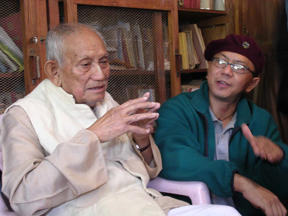
Morning: OJA KHELCHANDRA'S MANUSCRIPTS COLLECTION
I love the approach to Pabung’s house. The lane lined with bamboo. The flowering shrubs. The little houses you can see fleetingly behind them as you drive. The river snaking by his house.
Pabung is all dressed up to receive his guests. Such a gentleman. His sons Deben and Tombiraj by his side. We take off our shoes and enter his study.
I see he has taken some manuscripts out and laid them out carefully for his guests to look at. They are large handmade paper about 6 inches high and about 15 inches long. All are in Meitei Mayek, save for one, which Pabung gleefully points out is in Burmese. “They used the paper they captured from us in the War of 1819", he said, grinning, looking like Yoda. Another manuscript has a large fanciful drawing in black and red ink of a man – a physiological chart, Pabung tells us.
Pabung alternates between English and Manipuri. I try to translate. He speaks of the Four Gods, Koubru in the Northwest, Marjing in the Northeast, Wangbren in the Southeast and Thangjing in the Southwest. Why those orientations and not NSEW like all normal people? Mike wants to know. There must be an interesting answer but we are stumped. Pabung included. I wonder if that has something to do with magnetic north? Les wonders if there is a star in one of these directions Manipuris have taken their orientations from?
Pabung tells of Marjing and the story of his winged steed. And how his wings were clipped, so domesticating the horse and bringing the game of Polo to the Manipuris. Maybe we can go visit Marjing’s shrine at Hei’Ngang if that local politician ever returns my call. (Who am I kidding? No one returns calls in Manipur. They merely say days later, Oh, I heard you called. Thank you very much.)
I speak heartbrokenly of my failure to bring John. It will always remain for me the biggest failure of this trip. Maybe another group with him and Gene at the Rubin? After all Tamo Ratan and I seemed to have gotten some place with Gene in New York when we talked to him about setting up a manuscripts digitizing center in Manipur.
Despite my self-imposed rule of merely giving an immersive experience and not imposing any obligations on my friends, I take the opportunity to ask if we could all work together on a manuscripts project when we get back to New York. For one of my strategic objectives is to build a Manipur support circle with my friends. It is lonely without a community and, hey, the gals refuse any more help with their phanek sarongs already.
We leave, Bonnie taking pictures of the mothballs Pabung uses to preserve his 1000s of manuscripts.
Pabung see us to our cars and offers to walk us through Kangla Fort this afternoon. Boy, how can one refuse? But I have a chock-full schedule that keeps changing. But I say yes, and decide to worry about the scheduling later. Pabung will not hear of calling the Archaeological people; he will go and personally get permission. I say OK.
There is a way to do things here. Some will and must change. Some must not. Who decides what and how?
No comments:
Post a Comment